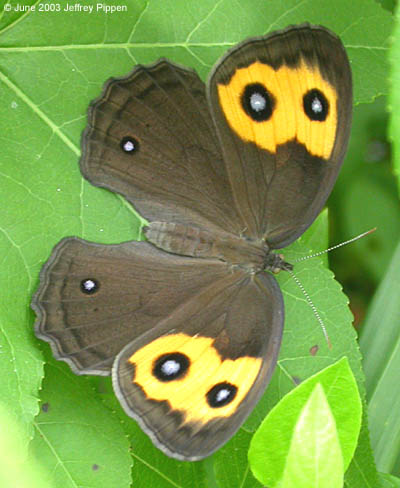Common Wood-Nymph
Cercyonis pegala
Cercyonis pegala is a butterfly ( butterfly ) of the family Nymphalidae ( Nymphalidae ).
- 5.1 Notes and references
- 5.2 Literature
Features
Butterfly
The forewing length of the moth is on average 26 mm in males and 30 mm in females. They are significantly larger than other species of the genus Cercyonis. Front and rear wings have on top and bottom of a brown color. The light brown to orange yellow Postdiskal and Submarginalregion forewing upper side there are two large, black, white cored ocelli, the lower is usually greater than the upper. The upper side of the hind wings is usually without markings, sometimes with a small eye spot. The wing undersides are brown marbled. On the fore wings the colors and eye-spots of the upper side shine through to the back; on the hind wings varies the number of different sized ocelli depending on the species occurs mostly between one and six.
Egg
The eggs are whitish in the tray, but soon take a dark color and more randomly scattered in the vicinity of grasses. A female lays up to 300 eggs.
Caterpillar
Younger caterpillars have a yellowish color, variety reddish brown side stripes and short hair all over the body. Adult animals are colored green, show dark side stripes and dots are yellow white including the head on the entire body length. At the end of the body, two short reddish peaks are visible.
Doll
The Stürzpuppe always has a green color, but varies depending on the area covered in the drawing elements. It may be coated with white, yellow or black stripes.
Similar Species
Cercyonis sthenele differs due to the smaller forewing length is 24 mm in males an average of 22 millimeters, and in the females and the fact that the lower ocellus on the forewing upper side is smaller than the upper. The species occurs only in the western U.S..
Subspecies
In addition to the nominate Cercyonis pegala pegala (Fabricius, 1775) the following sub- types can be distinguished:
- Cercyonis pegala abbotti (Brown, 1969)
- Cercyonis pegala Alope (Fabricius, 1793)
- Cercyonis pegala ariane ( Boisduval, 1852)
- Cercyonis pegala blanca ( Emmel & Mattoon, 1972)
- Cercyonis pegala boopis ( Behr, 1864)
- Cercyonis pegala Damei ( Barnes & Benjamin, 1926)
- Cercyonis pegala ino ( Hall, 1924)
- Cercyonis pegala nephele ( Kirby, 1837)
- Cercyonis pegala olympus ( Edwards, 1880)
- Cercyonis pegala stephensi ( Wright, 1905)
- Cercyonis pegala texana ( Edwards, 1880)
- Cercyonis pegala wheeleri ( Edwards, 1873)
Distribution and occurrence
The range of the species extends from Nova Scotia and New Brunswick west to British Columbia and south to California, Texas and Florida. It was also detected in Mexico. Cercyonis pegala preferred inhabited open grasslands and prairie landscape and forest edges.
Way of life
The moths fly in one generation from June to September. To accommodate nectar they like to visit different flowers. They suck more rarely on injured trees, moist soil sites or manure. The caterpillars feed on various grasses, such as the genus Andropogon or by Tridens flavus. In breeds also Kentucky bluegrass ( Poa pratensis ) is assumed. The pupa overwinters.









